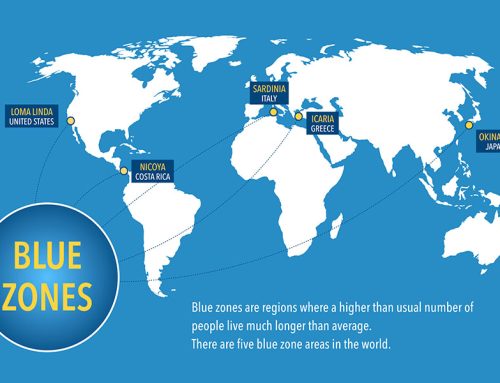Many fitness enthusiasts believe that unless cardio is high in intensity (like interval training or sprints), it’s not beneficial (“high intensity or nothing” mentality). In a similar train of thought. Most people believe that walking is not an intense enough exercise to improve your health very much and you’d get more benefit from running.
 It’s true that high intensity cardio, including interval training (HIIT) offers some big advantages, such as achieving improvements in health and fitness with very brief workouts. But does that mean lower intensity exercise like walking is not effective at all?
It’s true that high intensity cardio, including interval training (HIIT) offers some big advantages, such as achieving improvements in health and fitness with very brief workouts. But does that mean lower intensity exercise like walking is not effective at all?
Not according to a study from Lawrence Berkeley National Laboratory…
The results found that walking briskly can lower your chances of having high blood pressure, high cholesterol, and diabetes (all risk factors for heart disease) just as much as running (or more). In addition, the benefits increased in a dose-response manner.
There’s great confusion to this day about the benefits of cardiovascular exercise – including at various intensities (low vs moderate vs vigorous).
An even bigger problem is that the majority of people confuse health benefits, cardio fitness benefits, and fat loss benefits (three different subjects!)
This study looked at health benefits, specifically risk factors for cardiovascular disease in subjects ranging from 18 to 80 years old, clustered largely in their 40s and 50s. They found the following:
* Running reduced risk for first-time hypertension 4.2 percent and walking reduced risk 7.2 percent.
* Running reduced first-time high cholesterol risk 4.3 percent and walking 7 percent.
* Running reduced first time diabetes risk 12.1 percent compared to 12.3 percent for walking.
* Running reduced coronary heart disease risk 4.5 percent compared to 9.3 percent for walking.
Fascinating, isn’t it? They said benefits were “similar” but if you look at the numbers, walking was actually better.
Of course, the devil is in the details: they weren’t comparing equal amounts of time spent, like 30 minutes of walking vs 30 minutes of running (running would win that comparison). They were testing whether equal amounts of energy (calorie) expenditure by moderate intensity walking and vigorous intensity running provided equivalent benefits.
When energy expenditure was equivalent by moderate exercise (walking) and vigorous exercise (running) the health risk reductions were similar. But that does mean it takes a lot more time investment walking to achieve the same energy expenditure as you’d get with running.
In other words, high intensity exercise is more efficient than moderate or low intensity exercise.
So, contrary to what many people believe, it’s not that walking can’t benefit your health as much as higher intensity types of exercise, walking is simply not as time efficient.
It’s the same thing if we shift the subject to fat loss…
Low, moderate, and high intensity cardio can all help with fat loss, but the higher the intensity, the more efficient the exercise is, because it burns more calories per minute. This is why people who are short on time, and are physically able to do intense exercise, often choose the higher or moderate intensity cardio over lower intensity cardio.
The thing is, high intensity cardio is difficult and not appropriate for everyone. The author of the study, Paul Williams, pointed out that walking may be a more sustainable exercise for many people when compared to running.
He also said that people are always looking for an excuse not to exercise (“I can’t run or do HIIT because of my knee, my hip, my foot” etc. etc. ). Thanks to research results like these, perceived barriers to exercise have been removed…
We now know we can get the same health benefits (and fat loss benefits) from gentler, lower-impact exercise like walking as we do from running or other types of intense cardio, it will simply require more time. For example, you might have to walk 60 minutes to get equal benefits as 30 minutes of more intense exercise. Or, if 30 minutes is all you have, it will take more weeks or months to get where you want to go.
There’s a place for all kinds of cardio, depending on a person’s goals, needs, and preferences, and make no mistake, I’m a big fan of HIIT and other hard, brief cardio.
I also love walking and hiking and have been encouraging people to walk more for years. That’s one of the reasons I sponsor walking fitness challenges.
If you want a way to get healthier and leaner by walking, we are still accepting entries into our Burn the Fat Million step fitness challenge. You can still enter at the link below…
Just remember, you should jump in right away because the longer you wait, the more catching up you’ll have to do…
The Burn the Fat Million step fitness challenge is 100 days long but the official entry deadline was Monday the 18th. If you start 3 days late, you only have 97 days left, and with each additional day you wait, you’ll have yet another day less to accumulate your 1 million steps, which is the goal everyone is shooting for (10,000 steps a day!)
Walking is shockingly good for you (as the science now proves), so if you didn’t already, I hope you’ll jump in and accept the challenge. It’s a ton of fun and you get to socialize online with some great like-minded people.
To find out about the next Burn the Fat Million Step Challenge that you can enter, visit this page:
==> www.burnthefatinnercircle.com/public/Burn-The-Fat-Contest-Calendar.cfm
Train hard and expect success,
Tom Venuto,
Author, Burn the Fat, Feed the Muscle
Founder, Burn the Fat Inner Circle
PS. Scientific reference: Paul T. Williams, PhD and Paul D. Thompson, MD. Walking vs running for hypertension, cholesterol, & diabetes risk reduction, Arterioscler Thromb Vasc Biol. 33(5): 1085-1091. Berkeley National Laboratory.






Leave A Comment